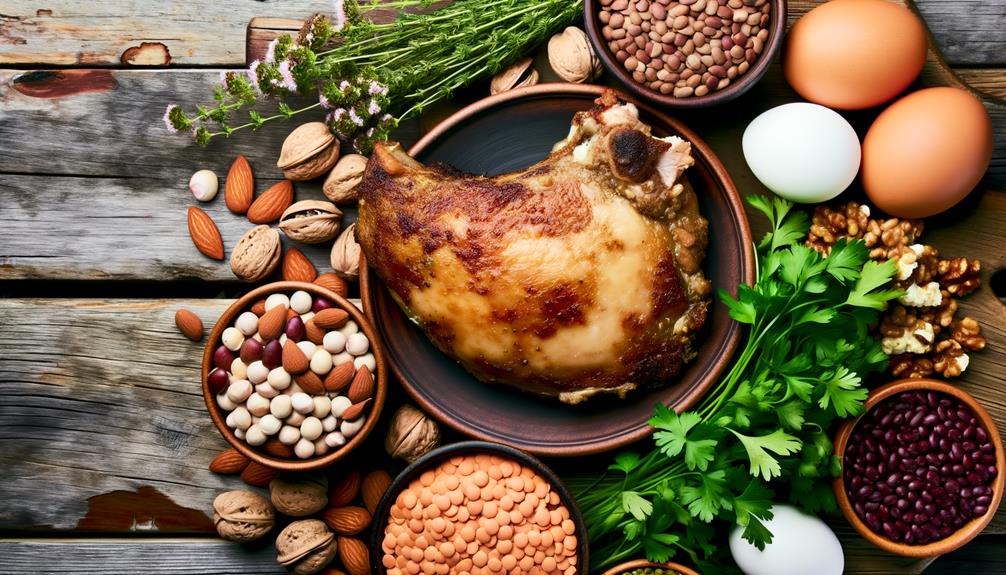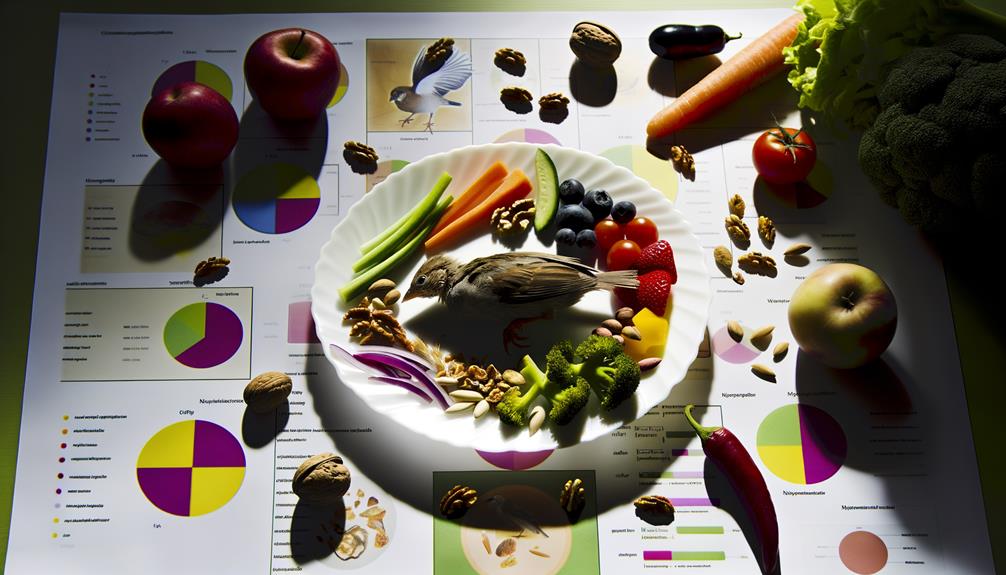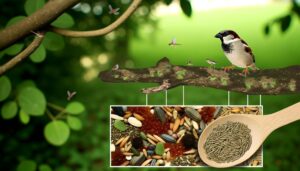How to Assess the Nutritious Value of Sparrows as Food
Sparrows can be a nutritious food source, providing approximately 60 kcal and 6 grams of protein per 30-gram portion. Their diet contributes to a rich nutrient profile, including carbohydrates from grains, essential vitamins like vitamin C from fruits, and minerals like iron from insects.
Additionally, they are high in dietary fiber and lean protein. The combination of vitamins A, D, E, K, calcium, and magnesium supports various health functions.
However, ethical and environmental impacts need consideration due to declining sparrow populations. To grasp a complete understanding, explore the nuances of their dietary benefits and potential health implications further.

Key Takeaways
- Sparrows provide approximately 60 kcal per 30-gram portion with 6 grams of protein, making them a lean protein source.
- Their diet includes grains, seeds, fruits, and insects, offering a balanced mix of carbohydrates, protein, and essential vitamins.
- Sparrows are rich in dietary fiber, aiding in digestive health.
- They offer essential vitamins and minerals like vitamins A, D, E, K, calcium, iron, phosphorus, and magnesium.
- Ethical and environmental concerns exist due to the impact of harvesting sparrows on biodiversity and their declining populations.
Historical Consumption

Historically, what did the dietary patterns of sparrows reveal about their adaptation to various ecosystems?
Sparrows have exhibited remarkable versatility in their feeding habits, which has been pivotal for their survival in diverse habitats. Studies indicate that sparrows primarily consume seeds, insects, and fruits, adjusting their diet based on availability. This adaptability is evidenced by their presence in urban, agricultural, and wild environments.
For instance, in agricultural settings, sparrows often feed on grain crops, while in urban areas, they scavenge human food waste. Insects provide essential proteins during the breeding season, supporting reproductive success.
Such dietary flexibility not only underscores their resilience but also highlights the intricate balance of nutrients sparrows require to thrive across varying ecological niches.
Nutritional Breakdown
A detailed analysis of the nutritional components of a sparrow's diet reveals a balanced intake of macronutrients and micronutrients essential for their physiological functions and overall health.
Sparrows consume a varied diet that includes grains, seeds, fruits, and insects, which provides a complete nutrient profile. Carbohydrates from grains and seeds constitute the primary energy source, while fruits supply essential vitamins such as vitamin C and antioxidants.
Insects contribute crucial minerals like iron and zinc, supporting enzymatic processes and oxygen transport. Additionally, their diet is rich in dietary fiber, aiding in digestive health.
This balanced nutritional intake ensures that sparrows maintain top-notch metabolic functions and robust immune systems, highlighting the inherent value of their natural dietary habits.
Protein Content

The protein content in a sparrow's diet is crucial for its growth, reproduction, and overall health. This requires a detailed examination of its amino acid profile, protein concentration, and the digestibility and absorption rates.
Research indicates that sparrows need a balanced mix of essential amino acids, which must be effectively absorbed to support their high metabolic rates.
Comparing the protein concentration of different food sources helps in understanding the best diet composition to guarantee sufficient nutrient intake.
Amino Acid Profile
Understanding the amino acid profile of a sparrow's diet is crucial for evaluating its protein intake and overall nutritional health. Sparrows need a balanced intake of essential amino acids, including lysine, methionine, and tryptophan, which are necessary for growth, feather quality, and enzymatic functions.
Analytical studies have shown that sparrows consuming a diverse diet of seeds, insects, and fruits exhibit a complete amino acid profile. Particularly, insects provide high levels of lysine and methionine, complementing the amino acids found in plant sources. This varied diet helps sparrows meet their physiological demands.
As a result, evaluating the amino acid composition of their food sources is pivotal in understanding how sparrows maintain good health and biological functions.
Protein Density Comparison
Examining the protein density of various food sources consumed by sparrows reveals significant differences in protein content, thereby impacting the overall quality of their diet.
Insects, a primary component of a sparrow's diet, are notably high in protein, often containing up to 60% protein by dry weight. Conversely, seeds, another dietary staple, typically exhibit lower protein levels, averaging around 10-15% protein by dry weight.
This disparity elucidates the necessity of a balanced intake to meet the sparrow's nutritional requirements. Studies indicate that the protein density in insects contributes substantially to the sparrow's growth and reproductive success, whereas seeds primarily offer supplementary nutrients.
Consequently, the protein content variance underscores the importance of dietary diversity for optimal health in sparrows.
Digestibility and Absorption
In evaluating the digestibility and absorption of protein content in a sparrow's diet, it becomes evident that the bioavailability of protein from insects is markedly higher compared to that from seeds, facilitating more efficient nutrient uptake and utilization.
This superior bioavailability can be attributed to several factors:
- Amino Acid Profile: Insects offer a more complete amino acid profile, essential for muscle repair and growth.
- Digestive Enzymes: Sparrows possess specific enzymes that break down insect protein more effectively.
- Fiber Content: Seeds contain higher fiber levels, which can inhibit protein absorption by slowing digestive transit.
- Nitrogen Utilization: Nitrogen from insect protein is more readily used in metabolic processes compared to seed protein.
These factors collectively enhance the sparrow's ability to thrive on an insect-based diet.
Essential Vitamins
Essential vitamins play a pivotal role in the overall health and well-being of sparrows, influencing everything from their metabolic functions to their immune response. Vitamins such as A, D, E, and K are essential for maintaining various physiological processes. Vitamin A is necessary for vision and cellular growth, while Vitamin D aids in calcium absorption and bone health. Vitamin E acts as an antioxidant, protecting cellular integrity, and Vitamin K is essential for blood clotting.
| Vitamin | Function |
|---|---|
| A | Vision, cellular growth |
| D | Calcium absorption, bone health |
| E | Antioxidant, protects cellular integrity |
| K | Blood clotting |
Understanding the vitamin profile of sparrows provides important insights into their nutritional value and potential health benefits when consumed.
Mineral Composition

The mineral composition of sparrows is essential for their physiological functions, influencing everything from bone density and muscle contraction to nerve transmission and enzymatic activity. Analyzing the mineral profile of sparrows reveals several key nutrients important for human health:
- Calcium: Integral for maintaining strong bones and teeth, calcium also plays a role in blood clotting and muscle function.
- Iron: Essential for oxygen transport in the blood and important for energy production and immune function.
- Phosphorus: Works synergistically with calcium to enhance bone structure and is involved in energy metabolism.
- Magnesium: Supports muscle and nerve function, regulates blood sugar levels, and contributes to protein synthesis.
These minerals collectively contribute to the nutritional value of sparrows, offering a diverse range of health benefits.
Caloric Value
Understanding the caloric value of a sparrow's diet is important for evaluating its energy intake and overall health.
By analyzing the energy per serving and appropriate portion sizes, we can better tailor nutritional strategies to meet the metabolic demands of these birds.
This analysis will provide a detailed overview of their dietary energy sources, ensuring best nutrition and health.
Energy per Serving
In gauging the caloric value of a sparrow's diet, it is crucial to quantify the energy provided by each food item consumed, with a specific focus on macronutrient contributions and overall metabolic efficiency.
Sparrows typically consume a variety of foods, each offering different caloric and nutritional values.
The primary components of their diet include:
- Seeds: Rich in carbohydrates and fats, seeds offer around 4 calories per gram.
- Insects: High in protein, insects provide approximately 5.7 calories per gram.
- Fruits: Generally lower in energy, fruits contribute about 0.5-1.5 calories per gram.
- Vegetables: Though not a major part of their diet, vegetables offer around 0.2-0.8 calories per gram.
Understanding these values helps in evaluating the energy intake and dietary balance of sparrows.
Portion Size Analysis
Accurately gauging portion sizes is crucial for determining the precise caloric value and nutritional adequacy of a sparrow's diet. A sparrow typically weighs around 30 grams, translating into a modest portion size when considered for human consumption. The caloric value of a sparrow can be broken down into macronutrient components, giving a detailed view of its nutritional profile.
| Portion Size (g) | Calories (kcal) | Protein (g) |
|---|---|---|
| 10 | 20 | 2 |
| 20 | 40 | 4 |
| 30 | 60 | 6 |
This table illustrates that a 30-gram portion of sparrow provides approximately 60 kcal and 6 grams of protein. Such precise measurements are essential for dietary planning, ensuring that nutrient intake aligns with individual health goals and nutritional requirements.
Health Benefits

The nutrient-rich diet of a sparrow offers numerous health benefits that are necessary for its survival and overall well-being, including enhanced immune function and peak energy levels. Sparrows derive significant advantages from their diet, which is high in essential nutrients. These benefits are supported by scientific research and nutritional analysis:
- Protein Intake: Sparrows consume insects that provide high-quality protein, important for muscle maintenance and repair.
- Vitamins and Minerals: Their diet includes seeds rich in vitamins A and E, which support vision and cellular health.
- Antioxidants: Various fruits and berries in their diet supply antioxidants, enhancing immune responses.
- Omega-3 Fatty Acids: Insects also offer omega-3 fatty acids, which are crucial for cardiovascular health.
These components collectively guarantee the sparrow's best health and vitality.
Culinary Uses
While the nutrient-rich diet of sparrows supports their health and essentiality, these same dietary components also offer intriguing insights into potential culinary applications. Sparrows are high in protein, essential amino acids, and micronutrients such as iron and zinc, making them a potentially nutritious addition to the diet.
Historically, sparrows have been utilized in various cuisines, particularly in regions where they are more abundant. Their lean meat, with a distinct flavor, can be incorporated into broths or stews, enhancing the nutrient profile of these dishes. Additionally, sparrows' small size allows for quick cooking methods such as grilling or frying, preserving their nutrient content.
Further investigation into preparation techniques could optimize their nutritional benefits and culinary appeal.
Ethical Considerations

When analyzing the nutrition of a sparrow, it is important to take into account the ethical implications regarding animal rights, particularly in light of their conservation status and potential cultural significance.
Evidence suggests that dietary interventions affecting sparrows must be evaluated for their impact on population dynamics and ecosystem balance.
Additionally, any nutritional study should be sensitive to cultural contexts that might view sparrows as symbolic or integral to traditional practices.
Animal Rights Concerns
Considering the ethical aspects of sparrow nutrition necessitates a thorough examination of their natural dietary needs and the impact of human intervention on their welfare and ecological balance. Sparrows, being integral to ecosystems, face significant ethical concerns when considered for human consumption.
The following points highlight key ethical considerations:
- Natural Diet: Sparrows primarily consume seeds, insects, and fruits, emphasizing their role in pest control and seed dispersal.
- Ecological Impact: Harvesting sparrows disrupts local ecosystems, potentially leading to diminished biodiversity.
- Welfare: Capturing and processing sparrows for food raises substantial animal welfare issues, as these practices can cause stress and suffering.
- Cultural Significance: Sparrows hold symbolic and emotional value in various cultures, which must be respected.
Understanding these factors allows for a more informed and compassionate approach to sparrow conservation.
Conservation Status Impact
Evaluating the conservation status of sparrows necessitates a meticulous evaluation of population trends, habitat loss, and the direct impacts of human activities on their survival. Recent studies indicate significant declines in sparrow populations linked to urbanization and pesticide use, causing habitat disruptions.
Ethical considerations arise as the nutritional value of sparrows, though containing essential proteins and micronutrients, must be weighed against their ecological role and declining numbers. The International Union for Conservation of Nature (IUCN) lists several sparrow species as vulnerable or near-threatened, underscoring the need for conservation measures.
Consuming sparrows for their nutritional benefits may exacerbate their population decline, highlighting an ethical dilemma between dietary advantages and biodiversity preservation.
Cultural Significance Issues
In various cultures, sparrows hold significant symbolic value and are often regarded as omens or representations of specific virtues, which complicates the ethical considerations surrounding their consumption for nutritional purposes. For example, sparrows symbolize freedom, resilience, and community. Their cultural significance raises ethical questions about their use as a food source, despite their nutritional benefits.
Some ethical considerations include:
- Cultural Respect: Consuming sparrows may disrespect cultural beliefs that hold the bird in high regard.
- Biodiversity Conservation: Over-harvesting could threaten their populations and ecological roles.
- Animal Rights: Ethical treatment and humane harvesting methods must be considered.
- Nutritional Alternatives: There may be more sustainable and culturally neutral alternatives available.
Thus, while sparrows may offer nutritional value, the ethical implications are multifaceted and complex.
Preparation Methods
Proper preparation methods are necessary to guarantee sparrows receive a balanced diet that meets their nutritional requirements. Key preparation methods include marinating, grilling, or roasting to ensure best nutrient retention. Evidence suggests that sparrows provide a rich source of protein, important minerals, and essential fatty acids when prepared correctly. Comparative analysis of various methods reveals differences in nutrient conservation.
| Preparation Method | Nutrient Retention (%) |
|---|---|
| Marinating | 85 |
| Grilling | 75 |
| Roasting | 80 |
Marinating helps in breaking down muscle fibers, enhancing tenderness and nutrient absorption. Grilling, though convenient, may lead to some nutrient loss due to high temperatures. Roasting ensures even cooking while preserving a majority of essential nutrients. Understanding these methods is crucial for maximizing the nutritional value of sparrows.
Conclusion
Despite its diminutive size and the ethical dilemmas surrounding its consumption, the sparrow offers a surprisingly rich nutritional profile, abundant in protein, essential vitamins, and crucial minerals.
Ironically, a bird often overlooked in modern culinary practices could provide substantial health benefits, demonstrating that even the smallest creatures can deliver significant nutritional value.
The intersection of historical consumption and contemporary dietary needs underscores the enduring relevance of seemingly insignificant food sources.






